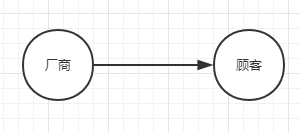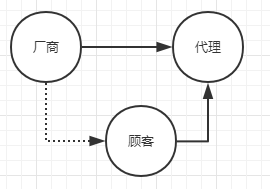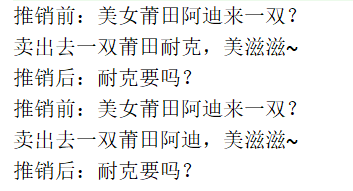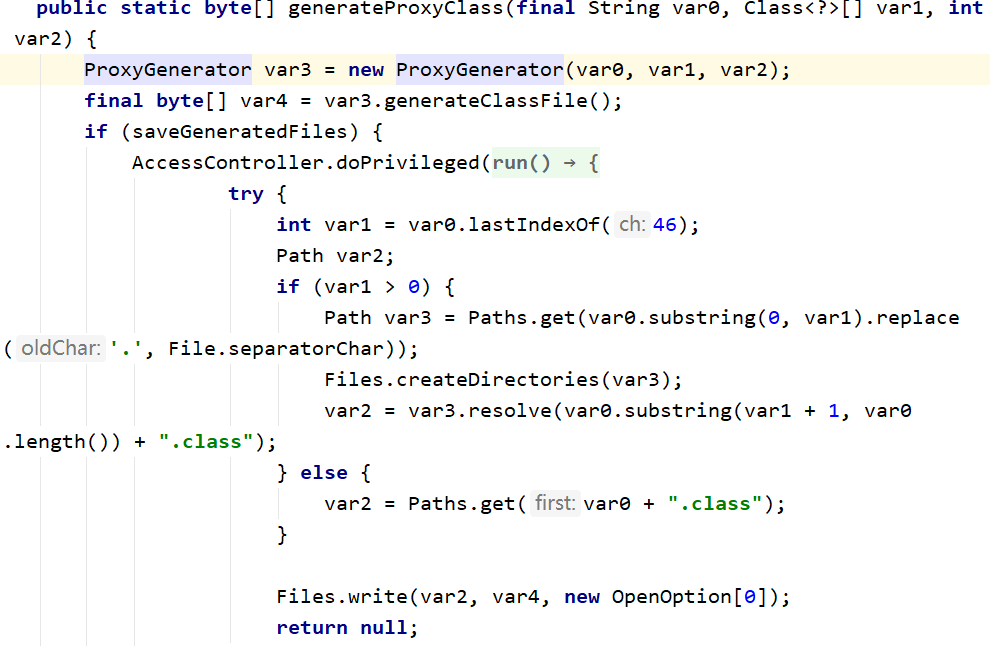Java 代理模式
被问到了,就补一下。
简述代理模式
代理是英文(Proxy)翻译过来的,在我们的实际生活中,最常见的代理模式应该是朋友圈中的微商了。在起初的时候,厂商直接对标顾客,没有微商在中间赚差价,结构就是如图。

之后慢慢的微商汇总了优质资源,顾客没必要自己去挑厂商货比三家,只需要从微商那里买就行了。所有就有了如下的结构:

而程序设计都是从生活中的实例出现的,所以Java中也产生了代理模式。
在Java中存在几种代理模式:
- 静态代理
- 动态代理
本文将一一介绍
静态代理
当我们看到了微商不厌其烦刷朋友圈的广告,耐不住优惠从微商那里买了一双,微商可能还会向我们推一些别的优惠活动之类的,那么这个过程我们用代码模拟一下。
首先我们需要有一个鞋子的接口,通用的接口是代理模式实现的基础。定义一个sell接口,代表鞋子可以被卖出去的能力。
package com.proxy.weishang;
// 定义鞋子接口
public interface Shoes {
void sell();
}
然后再来一个真正的鞋子类,需要实现Shoes的接口
package com.proxy.weishang;
// 真正的鞋子类
public class RealShoes implements Shoes {
@Override
public void sell() {
System.out.println("卖出了一双鞋子哦,美汁汁~");
}
}
和一个代理类(微商类)
package com.proxy.weishang;
// 微商 代理
public class MicroSell implements Shoes {
RealShoes realShoes;
public MicroSell(RealShoes realShoes) {
this.realShoes = realShoes;
}
public void setRealShoes(RealShoes realShoes) {
this.realShoes = realShoes;
}
@Override
public void sell() {
beforeSell();
realShoes.sell();
afterSell();
}
public void beforeSell() {
System.out.println("买之前宣传:帅哥,买双鞋子吗?高仿阿迪199两双");
}
public void afterSell() {
System.out.println("买之后推销:帅哥,再来双高仿耐克?");
}
}
接下来我们测试下
package com.proxy;
import com.proxy.weishang.MicroSell;
import com.proxy.weishang.RealShoes;
public class Main {
public static void main(String[] args) {
MicroSell microSell = new MicroSell(new RealShoes());
microSell.sell();
}
}
 在微商卖出鞋子的前后,执行了
在微商卖出鞋子的前后,执行了 beforeSell 和 afterSell 疯狂推销,那么使用代理模式的好处就在于这, 从之前最基本的厂商对顾客,鞋子只有单一的sell能力,而使用代理模式之后,我们并没有改变鞋子的sell能力就可以对其进行功能的拓展和附加 。
总结一下静态代理的优点:
- 无需修改被代理的对象
- 无损拓展功能
- 解耦合
缺点当然也存在:
- 要为每一个接口实现代理类,一旦接口增加方法,目标对象与代理对象都要维护。
动态代理
动态代理也是代理,他和静态代理的功能和目的是没有区别的,唯一的区别就在于动态代理是动态生成的,省去为接口实现代理类的操作。
何为动态生成
其实就是Java在内存中创建了一个实现接口的代理,而不需要我们自己定义。多说无益,看代码
我们仍然使用微商的例子来进行讲解。当微商想卖你莆田耐克的时候:
package com.proxy.dynamicProxy;
// 定义鞋子接口
public interface Shoes {
void sell();
}
package com.proxy.dynamicProxy;
// Nike鞋
public class NikeShoes implements Shoes {
@Override
public void sell() {
System.out.println("卖出去一双莆田耐克,美滋滋~");
}
}
package com.proxy.dynamicProxy;
import java.lang.reflect.InvocationHandler;
import java.lang.reflect.Method;
public class dynamicMicroSell implements InvocationHandler {
Object shoes;
public dynamicMicroSell(Object shoes) {
this.shoes = shoes;
}
public void setShoes(Object shoes) {
this.shoes = shoes;
}
@Override
public Object invoke(Object proxy, Method method, Object[] args) throws Throwable {
System.out.println("推销前:美女莆田阿迪来一双?");
method.invoke(shoes, args);
System.out.println("推销后:耐克要吗?");
return null;
}
}
测试下
package com.proxy;
import com.proxy.dynamicProxy.AdidasShoes;
import com.proxy.dynamicProxy.NikeShoes;
import com.proxy.dynamicProxy.Shoes;
import com.proxy.dynamicProxy.dynamicMicroSell;
import java.lang.reflect.Proxy;
public class Main {
public static void main(String[] args) {
NikeShoes nikeShoes = new NikeShoes();
dynamicMicroSell nikeSeller = new dynamicMicroSell(nikeShoes);
Shoes nikeProxy = (Shoes) Proxy.newProxyInstance(NikeShoes.class.getClassLoader(), NikeShoes.class.getInterfaces(), nikeSeller);
nikeProxy.sell();
}
}
 可以看到我并没有像静态代理那样重新实现一个代理类,而是实现了
可以看到我并没有像静态代理那样重新实现一个代理类,而是实现了 InvocationHandler 接口的invoke方法实现的代理。通过 Proxy.newProxyInstance() 创建了一个代理类来执行sell方法。
先不说InvocationHandler到底是什么东西,我们此时如果想要拓展一个阿迪鞋子的接口,应该怎么用动态代理实现?很简单,新建一个AdidasShoes还是实现Shoes接口
package com.proxy.dynamicProxy;
public class AdidasShoes implements Shoes {
@Override
public void sell() {
System.out.println("卖出去一双莆田阿迪,美滋滋~");
}
}
其他不需要变化,在main中通过dynamicMicroSell和Proxy.newProxyInstance()动态生成代理类就可以了
package com.proxy;
import com.proxy.dynamicProxy.AdidasShoes;
import com.proxy.dynamicProxy.NikeShoes;
import com.proxy.dynamicProxy.Shoes;
import com.proxy.dynamicProxy.dynamicMicroSell;
import java.lang.reflect.Proxy;
public class Main {
public static void main(String[] args) {
NikeShoes nikeShoes = new NikeShoes();
dynamicMicroSell nikeSeller = new dynamicMicroSell(nikeShoes);
Shoes nikeProxy = (Shoes) Proxy.newProxyInstance(NikeShoes.class.getClassLoader(), NikeShoes.class.getInterfaces(), nikeSeller);
nikeProxy.sell();
AdidasShoes adidasShoes = new AdidasShoes();
dynamicMicroSell adidasSeller = new dynamicMicroSell(adidasShoes);
Shoes adidasProxy = (Shoes) Proxy.newProxyInstance(AdidasShoes.class.getClassLoader(), NikeShoes.class.getInterfaces(), adidasSeller);
adidasProxy.sell();
}
}
运行如图

动态代理的优点是很明显的,它不需要为每一个接口都创建代理类,大大减少重复工作。
动态代理的秘密
在我们使用静态代理的时候,是通过 new MicroSell() 创建代理实例,动态代理肯定也有创建实例的动作,要找到在哪里创建了代理实例,我们需要跟进到Proxy.newProxyInstance()一探究竟
public static Object newProxyInstance(ClassLoader loader,
Class<?>[] interfaces,
InvocationHandler h)
throws IllegalArgumentException
{
Objects.requireNonNull(h);
final Class<?>[] intfs = interfaces.clone();
final SecurityManager sm = System.getSecurityManager();
if (sm != null) {
checkProxyAccess(Reflection.getCallerClass(), loader, intfs);
}
/*
* Look up or generate the designated proxy class.
*/
Class<?> cl = getProxyClass0(loader, intfs);
/*
* Invoke its constructor with the designated invocation handler.
*/
try {
if (sm != null) {
checkNewProxyPermission(Reflection.getCallerClass(), cl);
}
final Constructor<?> cons = cl.getConstructor(constructorParams);
final InvocationHandler ih = h;
if (!Modifier.isPublic(cl.getModifiers())) {
AccessController.doPrivileged(new PrivilegedAction<Void>() {
public Void run() {
cons.setAccessible(true);
return null;
}
});
}
return cons.newInstance(new Object[]{h});
} catch (IllegalAccessException|InstantiationException e) {
throw new InternalError(e.toString(), e);
} catch (InvocationTargetException e) {
Throwable t = e.getCause();
if (t instanceof RuntimeException) {
throw (RuntimeException) t;
} else {
throw new InternalError(t.toString(), t);
}
} catch (NoSuchMethodException e) {
throw new InternalError(e.toString(), e);
}
}
可以看到通过cl这个class反射调用其构造函数返回了一个实例
private static Class<?> getProxyClass0(ClassLoader loader,
Class<?>... interfaces) {
if (interfaces.length > 65535) {
throw new IllegalArgumentException("interface limit exceeded");
}
// If the proxy class defined by the given loader implementing
// the given interfaces exists, this will simply return the cached copy;
// otherwise, it will create the proxy class via the ProxyClassFactory
return proxyClassCache.get(loader, interfaces);
}
直接通过缓存获取,如果获取不到,注释说会通过 ProxyClassFactory 生成。
private static final class ProxyClassFactory
implements BiFunction<ClassLoader, Class<?>[], Class<?>>
{
// prefix for all proxy class names
private static final String proxyClassNamePrefix = "$Proxy";
// next number to use for generation of unique proxy class names
private static final AtomicLong nextUniqueNumber = new AtomicLong();
@Override
public Class<?> apply(ClassLoader loader, Class<?>[] interfaces) {
Map<Class<?>, Boolean> interfaceSet = new IdentityHashMap<>(interfaces.length);
for (Class<?> intf : interfaces) {
/*
* Verify that the class loader resolves the name of this
* interface to the same Class object.
*/
Class<?> interfaceClass = null;
try {
interfaceClass = Class.forName(intf.getName(), false, loader);
} catch (ClassNotFoundException e) {
}
if (interfaceClass != intf) {
throw new IllegalArgumentException(
intf + " is not visible from class loader");
}
/*
* Verify that the Class object actually represents an
* interface.
*/
if (!interfaceClass.isInterface()) {
throw new IllegalArgumentException(
interfaceClass.getName() + " is not an interface");
}
/*
* Verify that this interface is not a duplicate.
*/
if (interfaceSet.put(interfaceClass, Boolean.TRUE) != null) {
throw new IllegalArgumentException(
"repeated interface: " + interfaceClass.getName());
}
}
String proxyPkg = null; // package to define proxy class in
int accessFlags = Modifier.PUBLIC | Modifier.FINAL;
/*
* Record the package of a non-public proxy interface so that the
* proxy class will be defined in the same package. Verify that
* all non-public proxy interfaces are in the same package.
*/
for (Class<?> intf : interfaces) {
int flags = intf.getModifiers();
if (!Modifier.isPublic(flags)) {
accessFlags = Modifier.FINAL;
String name = intf.getName();
int n = name.lastIndexOf('.');
String pkg = ((n == -1) ? "" : name.substring(0, n + 1));
if (proxyPkg == null) {
proxyPkg = pkg;
} else if (!pkg.equals(proxyPkg)) {
throw new IllegalArgumentException(
"non-public interfaces from different packages");
}
}
}
if (proxyPkg == null) {
// if no non-public proxy interfaces, use com.sun.proxy package
proxyPkg = ReflectUtil.PROXY_PACKAGE + ".";
}
/*
* Choose a name for the proxy class to generate.
*/
long num = nextUniqueNumber.getAndIncrement();
String proxyName = proxyPkg + proxyClassNamePrefix + num;
/*
* Generate the specified proxy class.
*/
byte[] proxyClassFile = ProxyGenerator.generateProxyClass(
proxyName, interfaces, accessFlags);
try {
return defineClass0(loader, proxyName,
proxyClassFile, 0, proxyClassFile.length);
} catch (ClassFormatError e) {
/*
* A ClassFormatError here means that (barring bugs in the
* proxy class generation code) there was some other
* invalid aspect of the arguments supplied to the proxy
* class creation (such as virtual machine limitations
* exceeded).
*/
throw new IllegalArgumentException(e.toString());
}
}
}
可知代理类名为 String proxyName = proxyPkg + proxyClassNamePrefix + num ,即 包名+$Proxy+id序号
生成代理类的核心代码
byte[] proxyClassFile = ProxyGenerator.generateProxyClass(proxyName, interfaces, accessFlags); return defineClass0(loader, proxyName,proxyClassFile, 0, proxyClassFile.length);

通过修改Java字节码的形式定义class,这就是动态代理自动生成的秘密。来看下动态代理的类名

总结
代理模式被运用于spring框架的aop面向切面编程中,个人业务需求可以应用在日志记录、性能统计等场景中。
最后几句话总结下:
- 代理模式的好处在于不修改现有代码的基础上进行拓展功能
- 不管是动态还是静态代理都要实现接口,本质是面向接口编程
- 静态代理需要自己实现Proxy类,动态由Proxy.newInstance()反射动态生成
- 两者区别在于是否需要自己手动实现Proxy类











![[HBLOG]公众号](https://www.liuhaihua.cn/img/qrcode_gzh.jpg)

